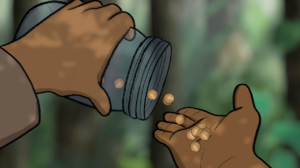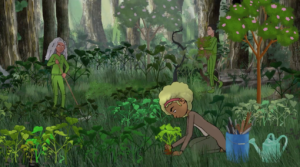Building Narrative Power
Toolkit
Moving from powerful narratives to narrative power
Authored by Higher Ground Change Strategies & Berkeley Media Studies Group
Like going on a long road trip, it’s knowing where we want to go, having the mechanics ready to fine tune our vehicle, with training under our belts so we know to swerve around potholes, and sometimes even drive bulldozers if we need to create new roads.
This toolkit is designed to help you explore actions you and others can take to build narrative power where you live and work.
Narrative power is the ability to make the foundation stories we tell—the stories about how things work, our sense of history, who and what matters, and our relationship to one another and the planet—the main stories people use to make sense of the world over time. We don’t build narrative power by simply telling stories.
We build narrative power by rooting and reinforcing our stories across the many institutions and cultural spaces that shape what we think, know, and believe.
So narrative power is not about any one story and it’s not just about storytelling. Narrative power is also about changing—or creating!—the institutions that reproduce our world views not only in what they say but also in what they do.
Building narrative power requires a combination of strategies.

Strategies to Tend the Soil:
Advocate for policies that expand the infrastructure to root and reproduce our ideas and values.
If narrative power is a forest grown strong, this is the work we do to create a healthy environment for planting our narratives.

Strategies to Plant & Cultivate Seeds:
Develop and share our values, ideas and stories so that they are aligned, clear and effective.
This is the work we do to make sure that our narratives seeds are healthy and strong so they’ll grow with the depth and reach we need.

Strategies to Prune the Forest:
Disrupt harmful narratives that help drive systemic inequities.
This is the work we do to uproot harmful, unhealthy narratives so that our ideas and values will thrive.
Over time, we need to move on the whole range of strategies for building narrative power but not every organization has to work on every aspect. Some groups may focus on one or another aspect of change—tending, cultivating, or pruning—depending on who they are, what they prioritize, and what their partners are doing.
Key questions to help clarify direction
We need to be bold and fearless in imagining the world we are trying to create. Even though developing a clear vision of where we want to go can be the hardest part of our planning, this is precisely what lets us measure progress and achievements. With a vision, we can assess whether the short-term opportunity is actually taking us in the direction we seek. A clear direction prevents us from confusing short-term opportunities and objectives with our long-term goals for change.
- How are you using this moment to build narrative power?
- What criteria can help you assess conditions and identify the near- and long-term outcomes you seek?
- What are the conditions that are hindering or helping you?
When you begin to imagine and act as if you are living in the world you want to live in, you will have company.
– Bernice Johnson Reagon –
Even if we don’t win everything in one campaign, we are creating more possibility with everything we do change—creating what theoretical biologist Stuart Kauffman has coined as “the adjacent possible.” We literally change what’s possible with each stride we make. We can ask ourselves: What is the adjacent possible that leads to narrative power?
Explore new ideas and how others have done it
Identify the game changers. While specific strategy work for building narrative power and creating new narratives will come largely out of an assessment of the current conditions and visions for transformative change, one way to explore new ideas is to examine how others have done it. Below are examples of work fundamentally restructuring dominant narrative across all three strategy areas. What can you add?
Tending the Soil
Planting Seeds & Cultivating Plants
Pruning the Forest
Close All (DO NOT DELETE)
Education
Education
Tending the Soil
Transform school curricula, from textbooks to training teachers, including ensuring accurate, honest teaching of history.
Example: Teaching for Change
Teach the Truth Campaign
Planting Seeds & Cultivating Plants
Nikole Hannah-Jones and her team at the New York Times conducted in-depth reporting on the U.S. origin story, explaining the pivitol roller of slavery in the nation's history. The 1619 Project continues to advance stories that help explain and contextualize contemporary social problems and their roots in structural racism.
Pruning the Forest
Growing and coordinated efforts (dating back to the 1970s) to document and draw attention to sexism in mathematics textbooks and advocate for better, "more modern" textbooks that are free of gender bias.
Arts & Archival Institutions
Arts & Archival Institutions
Tending the Soil
Establish public and private funds to support the institutionalization of our stories and imagery (i.e., in museums and as creative projects); sustain and expand alternative media and diverse voices and creators in media and culture across platforms.
Example: Establishing Civil Rights Museums
Planting Seeds & Cultivating Plants
The Monuments Project at the Mellon Foundation seeks “to transform the nation’s commemorative landscape by supporting public projects that more completely and accurately represent the multiplicity and complexity of American stories.”
Pruning the Forest
The removal of statues and other monuments that commemorate racism and conquest.
Smokefree Media efforts to pressure movie studios to stop depicting tobacco in films that kids were likely to watch. https://smokefreemedia.ucsf.edu/
Mass Media
Mass Media
Tending the Soil
Require public broadcasters to present controversial issues fairly; establish other policies that hold media outlets and platforms accountable to strong equity and access standards.
Examples: Equal time doctrines and public oversight and licensing for outlets.
Planting Seeds & Cultivating Plants
Creating special “beats” at news outlets like dedicated labor, housing, or equity reporting.
Pruning the Forest
A broad coalition of organizations are working to eliminate hate speech from social media platforms. In the Change the Terms campaign, advocates conducted independent, community-led policy research and analysis to document the harms and provide evidence supporting the demands. The coalition is applying high profile pressure on the major social media platforms, calling out their irresponsible disregard for their own policies that amplify harmful content.
Housing
Housing
Tending the Soil
Establish housing as a human right and a critical social good rather than as a commodity to generate wealth.
Example: Causa Justa::Just Cause and Alameda County Public Health Department’s collaboration Development without Displacement
Planting Seeds & Cultivating Plants
Advocates and public health practitioners illustrated how displacement harms those forced out, those left behind, and our entire society, pointing to solutions that protected tenants and emphasized non-market based approaches to housing and community development. The new narrative was a foundation for community meetings, legislative hearings, news conferences, developing policy platforms, and more.
Pruning the Forest
The Development without Displacement report challenged dominant narratives that increase inequity; prepared spokespeople to pitch alternative stories that reframed housing as a health issue; and used the new narratives in work to advance specific solutions.
Transportation
Transportation
Tending the Soil
Develop a legal and policy framework that ensures access to public goods and services for everyone, including those living with disabilities.
Example: ADAPT advocacy to establish local and national transportation access and more, including the enactment of the Americans with Disabilities Act
Planting Seeds & Cultivating Plants
Disability rights activists shifted local, state, and federal policy while also shifting the narrative about themselves. They became the protagonists in their own stories, changing the narrative from one of people to be shut off from society and pitied, to people with a right to be visible, included and with agency.
Pruning the Forest
Environment
Environment
Tending the Soil
Challenging the fundamental, deeply embedded idea that our actions have no impact on climate, that “it is just nature doing what nature does.”
Example: Developing fields of study to forge a broad and credible body of knowledge on the climate crisis. Building public support and understanding of the climate crisis by embedding their ideas across a range of structures.
Planting Seeds & Cultivating Plants
Developing and disseminating school curricula including climate and environment related math problems; establishing endowed chairs and degree programs in ecology, climate, and sustainability; establishment of environmental impact reports; journals, documentary and commercial films, books, music and children’s literature. This narrative infrastructure was developed to support its agenda for structural change.
Pruning the Forest
- How does this campaign or action build structural and narrative power for not only this campaign, but future work to reach our vision?
- Who else do we need to partner with to change the current narrative and build narrative power?
- What does it mean to do this work with “community at the center”? What happens when community leads?
- What do we need to build internal capacity? Do we need well-trained spokespeople? Do we need people in other positions to carry the work?
- What do we need to build a robust infrastructure to support or create out own spaces to tell our stories? How do we get our people to the microphone?
We also need to build narrative power infrastructure. This means developing the tools and support systems that advocates at all levels (local, state, national) need to do the work and make progress.
Infrastructure includes:
- Operating support for the groups doing the organizing, advocacy, and research;
- Technical assistance for those groups on policy, law, science, community organizing, and coalition building; and
- Various supports for direct communication, such as:
-
- Support for newsrooms to better reflect their audiences and tools and training for journalists to tell more complete stories
- Media advocacy training and support for residents, advocates, and journalists’ other sources.
-
A well-developed infrastructure fosters a network of organizers, advocates, researchers, and media makers, convening them to stimulate creative thinking, learn from each other, and cement relationships and commitments to creating our healthy future.
